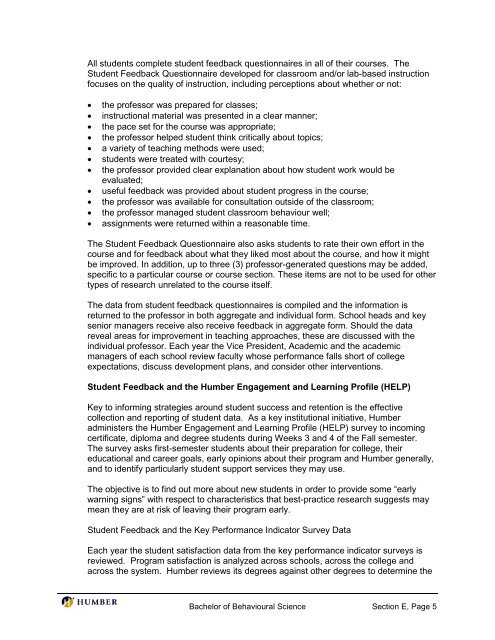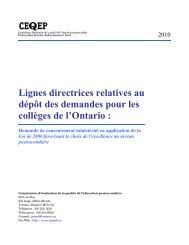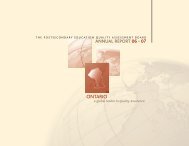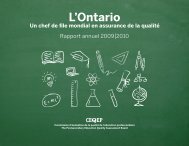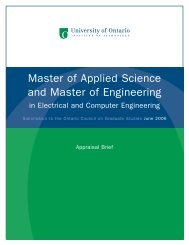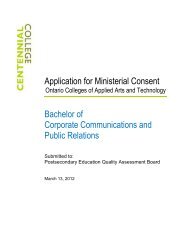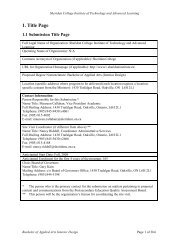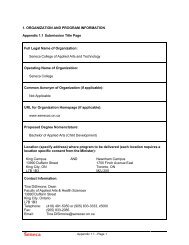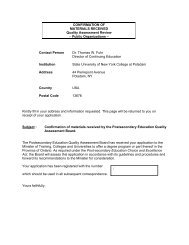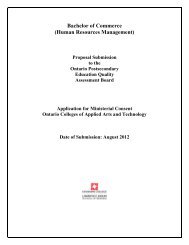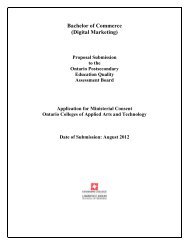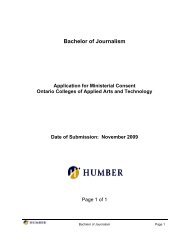Bachelor of Behavioural Science - Postsecondary Education Quality ...
Bachelor of Behavioural Science - Postsecondary Education Quality ...
Bachelor of Behavioural Science - Postsecondary Education Quality ...
You also want an ePaper? Increase the reach of your titles
YUMPU automatically turns print PDFs into web optimized ePapers that Google loves.
All students complete student feedback questionnaires in all <strong>of</strong> their courses. The<br />
Student Feedback Questionnaire developed for classroom and/or lab-based instruction<br />
focuses on the quality <strong>of</strong> instruction, including perceptions about whether or not:<br />
<br />
<br />
<br />
<br />
<br />
<br />
<br />
<br />
<br />
<br />
<br />
the pr<strong>of</strong>essor was prepared for classes;<br />
instructional material was presented in a clear manner;<br />
the pace set for the course was appropriate;<br />
the pr<strong>of</strong>essor helped student think critically about topics;<br />
a variety <strong>of</strong> teaching methods were used;<br />
students were treated with courtesy;<br />
the pr<strong>of</strong>essor provided clear explanation about how student work would be<br />
evaluated;<br />
useful feedback was provided about student progress in the course;<br />
the pr<strong>of</strong>essor was available for consultation outside <strong>of</strong> the classroom;<br />
the pr<strong>of</strong>essor managed student classroom behaviour well;<br />
assignments were returned within a reasonable time.<br />
The Student Feedback Questionnaire also asks students to rate their own effort in the<br />
course and for feedback about what they liked most about the course, and how it might<br />
be improved. In addition, up to three (3) pr<strong>of</strong>essor-generated questions may be added,<br />
specific to a particular course or course section. These items are not to be used for other<br />
types <strong>of</strong> research unrelated to the course itself.<br />
The data from student feedback questionnaires is compiled and the information is<br />
returned to the pr<strong>of</strong>essor in both aggregate and individual form. School heads and key<br />
senior managers receive also receive feedback in aggregate form. Should the data<br />
reveal areas for improvement in teaching approaches, these are discussed with the<br />
individual pr<strong>of</strong>essor. Each year the Vice President, Academic and the academic<br />
managers <strong>of</strong> each school review faculty whose performance falls short <strong>of</strong> college<br />
expectations, discuss development plans, and consider other interventions.<br />
Student Feedback and the Humber Engagement and Learning Pr<strong>of</strong>ile (HELP)<br />
Key to informing strategies around student success and retention is the effective<br />
collection and reporting <strong>of</strong> student data. As a key institutional initiative, Humber<br />
administers the Humber Engagement and Learning Pr<strong>of</strong>ile (HELP) survey to incoming<br />
certificate, diploma and degree students during Weeks 3 and 4 <strong>of</strong> the Fall semester.<br />
The survey asks first-semester students about their preparation for college, their<br />
educational and career goals, early opinions about their program and Humber generally,<br />
and to identify particularly student support services they may use.<br />
The objective is to find out more about new students in order to provide some “early<br />
warning signs” with respect to characteristics that best-practice research suggests may<br />
mean they are at risk <strong>of</strong> leaving their program early.<br />
Student Feedback and the Key Performance Indicator Survey Data<br />
Each year the student satisfaction data from the key performance indicator surveys is<br />
reviewed. Program satisfaction is analyzed across schools, across the college and<br />
across the system. Humber reviews its degrees against other degrees to determine the<br />
<strong>Bachelor</strong> <strong>of</strong> <strong>Behavioural</strong> <strong>Science</strong> Section E, Page 5


